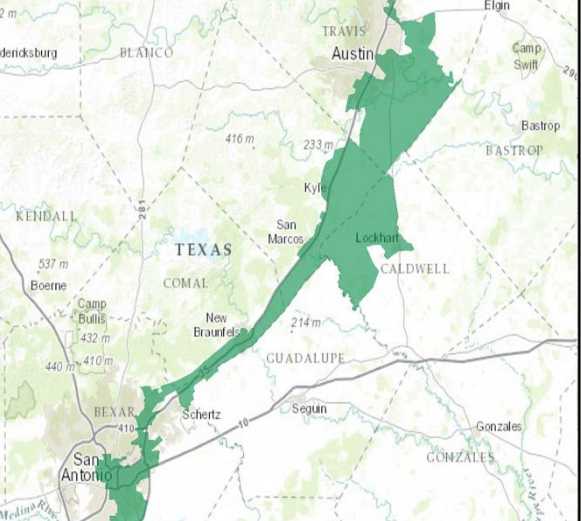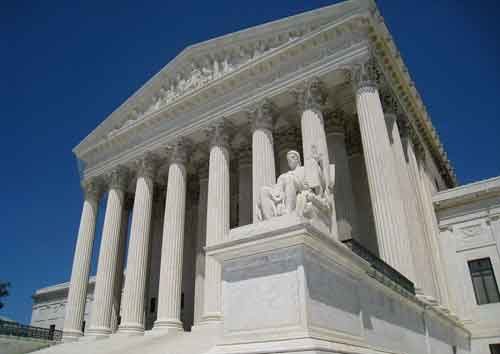On Monday, the Supreme Court heard arguments in a Texas redistricting case that could have major implications for minority voters — as well as determine which party is likely to control Congress after the 2012 elections.
Here’s our guide to why the case matters, why it could pose a challenge to part of the Voting Rights Act, and what impact the Court’s ruling could have on voters across the country.
Our update on Monday’s oral arguments is here.
How did this case end up in front of the Supreme Court?
At its most basic, the case is contesting which district maps Texas will use in the 2012 elections.
This seems like a dry question, but it’s not. Thanks to population growth, Texas is gaining four seats in Congress, and how the district lines are drawn is likely to determine whether those additional seats will be won by Democrats or Republicans — and how big an impact minority voters will have in deciding who the new representatives will be.
Because those four seats could help determine which party controls the House of Representatives, the Texas case is being closely watched across the country.
As it has done before, the Republican-dominated state legislature drew maps that heavily favor Republicans.
At least three of the four new congressional districts were drawn in a way that seemed likely to favor Anglo Republican candidates — even though Latinos and African-Americans accounted for most of the state’s population growth.
The legislature’s maps immediately faced legal challenges from minority groups who argued that the lines were drawn to purposefully weaken the ballot power of Latino voters — as well as from the Department of Justice, which argued that Texas’ state house and congressional map plans [7] are illegal because they diminish the ability of minority voters to elect the candidate of their choice.
Because the ongoing legal battle over the legislature’s maps was interfering with the state’s election schedule, the federal district court in San Antonio drew an alternate set of maps for the state to use.
These maps are seen as being more favorable to minority voters — as well as much friendlier to Democrats.
Rather than use these court-drawn maps, the state of Texas appealed the case to the Supreme Court, arguing that the state court overstepped its bounds, and that, because of the time-crunch, the legislature’s original plans should be used for the 2012 elections — even though the federal government has yet to give the plans “preclearance.”
The Problem with ‘Preclearance’
This is where the case bumps up against the Voting Rights Act. Section 5 of the 1965 act requires that certain states with a history of racial discrimination — including Texas — get federal “preclearance,” or approval, before implementing any laws that affect voting.
The Texas legislature’s original plans haven’t received preclearance yet — and it’s unlikely that they will before this year’s elections.
While most states simply ask for preclearance from the Department of Justice, Texas has taken the less-common, more-expensive route of asking for approval from a panel of federal judges in Washington.
In denying summary judgment on the case, those judges have already concluded that “the State of Texas used an improper standard to determine which districts afford minority voters the ability to elect their preferred candidate of choice.”
But the final ruling on preclearance is unlikely to come soon enough to get Texas’ already delayed election season underway.
By asking the Supreme Court to use the state legislature’s maps before they have received federal preclearance, Texas is essentially trying to perform a temporary end-run around the Voting Rights Act’s “preclearance” requirement.
Texas is arguing that this move is perfectly legal, and would not affect the state’s “undisputed obligation” to get federal preclearance before using its new maps “on a permanent basis.”
Nina Perales, the director of litigation for the Mexican American Legal Defense and Education Fund , told the Washington Post that this move “flips Section 5 completely on its head,” and argued the state was trying to squeeze in one more election cycle before having to reckon with the growing power of Latino voters.
Updated 1/10/2012: How is the Court likely to rule?
The fact that the Supreme Court decided to hear the case at all makes it seem unlikely that the justices will simply endorse the maps drawn by the federal court in San Antonio.
During oral arguments yesterday, several members of the Court suggested that the San Antonio court may have overstepped its bounds in the way it drew its interim maps — particularly in its creation of new minority districts.
But the Court also made it fairly clear that it was not interested in overturning Section 5 of the Voting Rights Act — at least, not at the moment.
“The constitutionality of the Voting Rights Act is not at issue here, right?” Chief Justice John Roberts, Jr. asked at one point.
Only Justice Antonin Scalia said that the San Antonio court should temporarily implement the Texas legislature’s plan.
Justices Sonia Sotomayor and Elena Kagan emphasized that Section 5 banned the use of a plan that had not received federal approval, and Chief Justice Roberts seemed to agree, noting, “You cannot assume that the legislature’s plan should be treated as if it were precleared.”
But the consensus of the court seemed to be that it was just as problematic for the San Antonio court to assume that the legislature’s map was an illegal gerrymander, and then redraw the map on the assumption that all of the minority groups concerns were legitimate.
Justice Samuel Alito suggested that the judicial branch had no business getting involved in making policy via map lines. “To say they are going to apply neutral districting principles is a subterfuge,” he said. “There is no such thing.”
Justice Alito suggested that the best solution might simply be to wait for the Washington, D.C., court to either grant or deny preclearance on the Texas legislative maps — and to delay Texas’ primary schedule again in the meantime.
Justice Kagan suggested a compromise plan, in which Texas’ court-drawn interim maps would more closely resemble the maps drawn by the legislature.
Attorneys for both sides said this plan would be preferable to simply implementing their opponents’ maps.
As the Washington Post’s Aaron Blake noted last month, such a compromise would still set a new precedent. “Currently, court-drawn maps are drawn with deference to the last constitutionally-approved map available (i.e. the existing map). Changing the standard would give state legislatures greater power over the final product, even in the event that their maps are invalidated,” he wrote.
Updated 1/10/12: Earlier Speculation on the Court and the Voting Rights Act
At minimum, the Supreme Court will have to rule on what maps Texas should use in its upcoming election.
As Lyle Denniston of SCOTUSblog put it, “The Court must either draft maps of its own, accept — even grudgingly — something that already exists, or find a streamlined way to get the District Court in San Antonio to craft a plan that minimally alters the state’s maps.”
But there’s been speculation that the Court could also use the case as an opportunity to address the constitutionality of Section 5 of the Voting Rights Act, the part that requires certain states to obtain preclearance of plans that affect minority voters.
The Washington Post’s Aaron Blake called this “the Nuclear Option.” One of the key elements of preclearance is that it places the burden of proof on the state governments to prove that their plans are not discriminatory, rather than requiring minority groups to organize and pay for expensive legal challenges. By invalidating the Section 5 preclearance requirement, the Supreme Court “would allow these states greater freedom to draw their maps and increase the burden on minority groups and others who may fight the maps in court,” Blake wrote.
The Supreme Court seemed to come close to overturning Section 5 two years ago, in another case from Texas. That decision made it clear that the Court had serious reservations about the limits the Voting Rights Act places on a state’s sovereignty.
In that ruling, Chief Justice John Roberts Jr. wrote that “the Act now raises serious constitutional concerns,” and that it “differentiates between the States in ways that may no longer be justified.”
This time around, the conservative Cato Institute has submitted an amicus brief to the Texas case asking the Court to review the constitutionality of the Voting Rights Act, arguing that the statute “no longer serves its original purpose.”
But some experts doubt that the Supreme Court will tackle Section 5’s constitutionality in the Texas case.
Richard Pildes, a New York University law professor, told MSNBC, “The court recognizes that it must act more quickly than usual, given the time pressures involved with primary elections looming shortly down the road. For all those reasons, the court is likely to focus on the narrowest issues needed to resolve the particular legal issues presented.”
Cato isn’t alone in its opposition of the Voting Rights Act. Georgia Congressman Lynn Westmoreland, the Republicans’ point man for congressional redistricting, has long opposed the act, calling it “outdated, unfair and unconstitutional.” In a speech opposing the extension of the act in 2006, Westmoreland argued that Georgia’s record of voter equality “can stand up to any other state in the nation” and that the Voting Rights Act’s renewal would “keep my state in the penalty box for 25 more years based on the actions of people who are now dead.”
But the Voting Rights Act also has strong, bipartisan support. President George W. Bush gave it high praise. Executives from Wal-Mart, AT&T, Pfizer, Coca-Cola, Disney and other large corporations wrote to Bush urging him to reauthorize the law and describing it as a cornerstone of American society. The Senate ultimately approved the 2006 extension of the act 98-0, and the House 390-33.
Although the Supreme Court may have decided not to tackle the constitutionality of the Voting Rights Act in the Texas case, it may soon have other opportunities to address the issue.
A case in which a county in Alabama is challenging the constitutionality of Section 5 of the Voting Rights Act is scheduled for oral arguments in the U.S. Court of Appeals on January 19.
The Department of Justice’s move to strike down South Carolina’s Voter ID law under Section 5 of the Voting Rights Act may also spark a case that could make its way to the Supreme Court.




